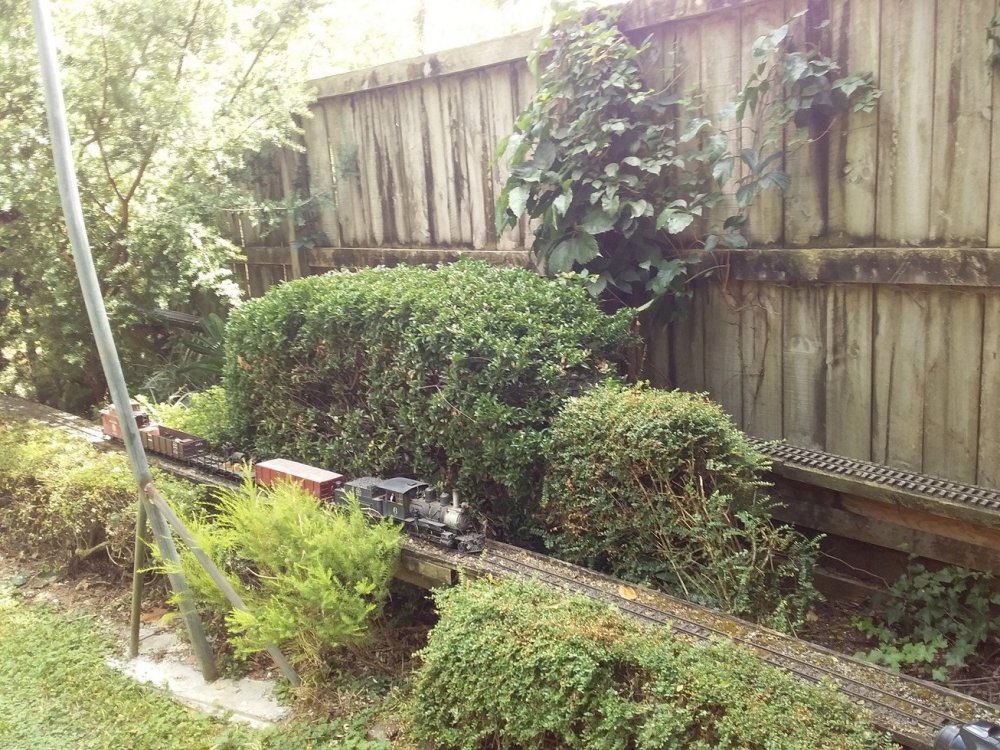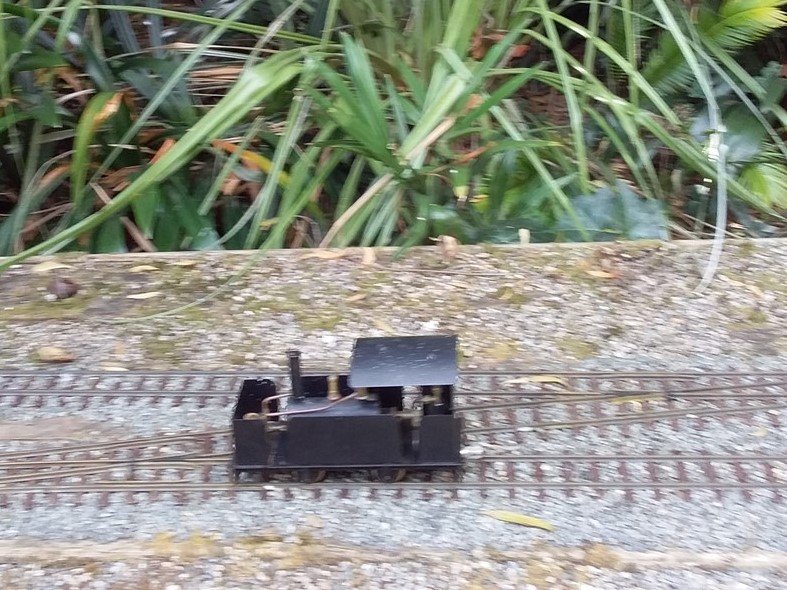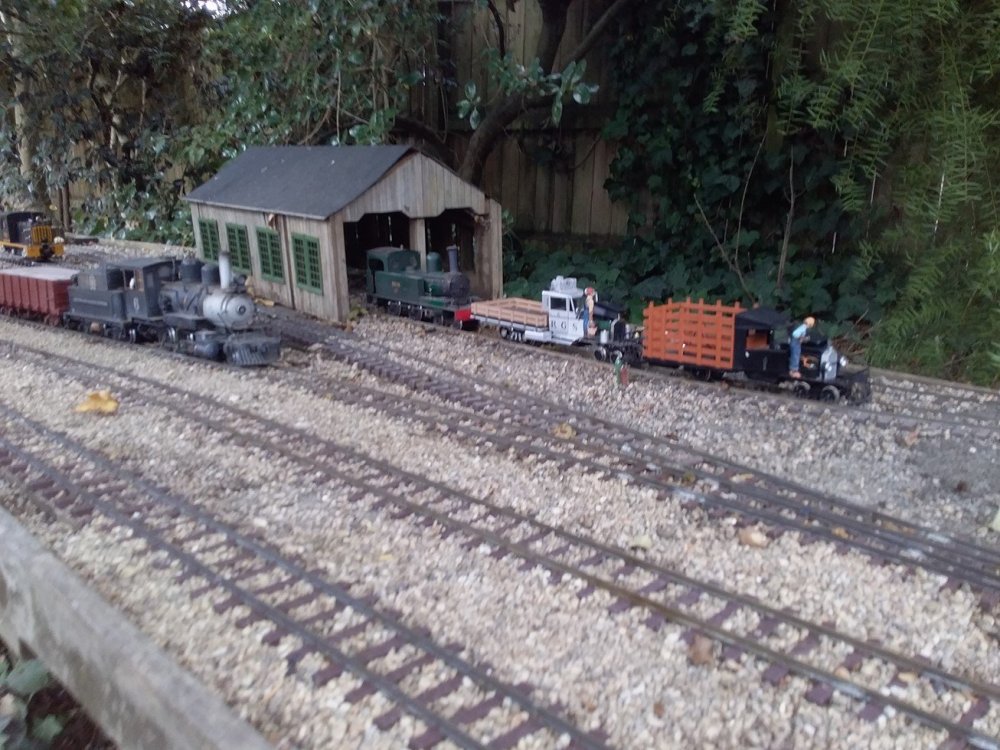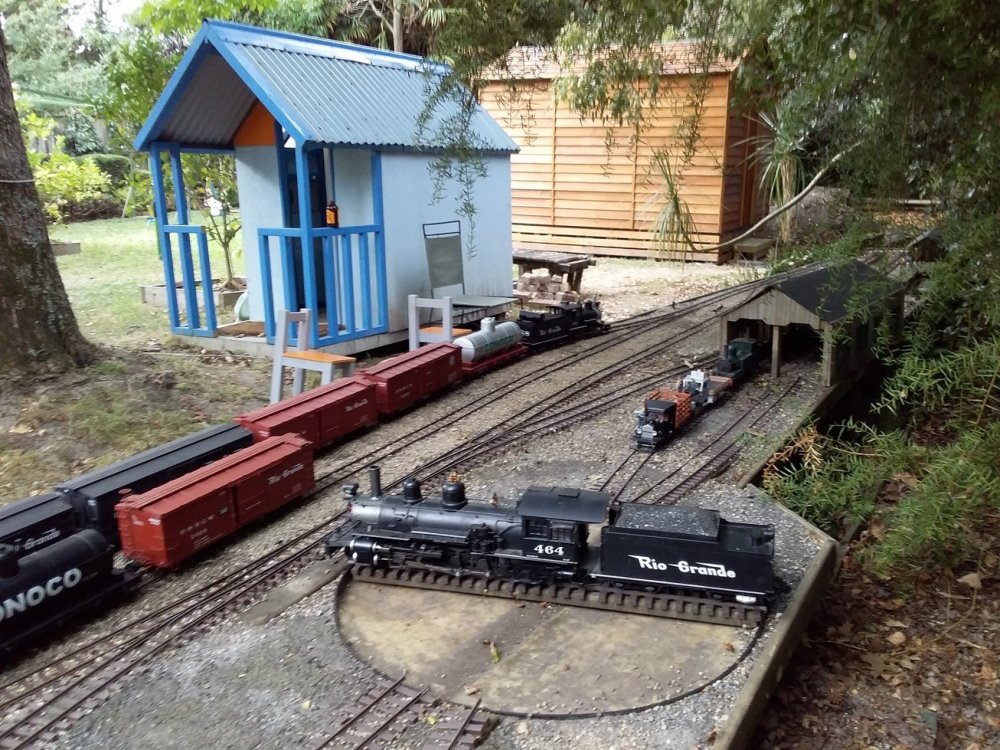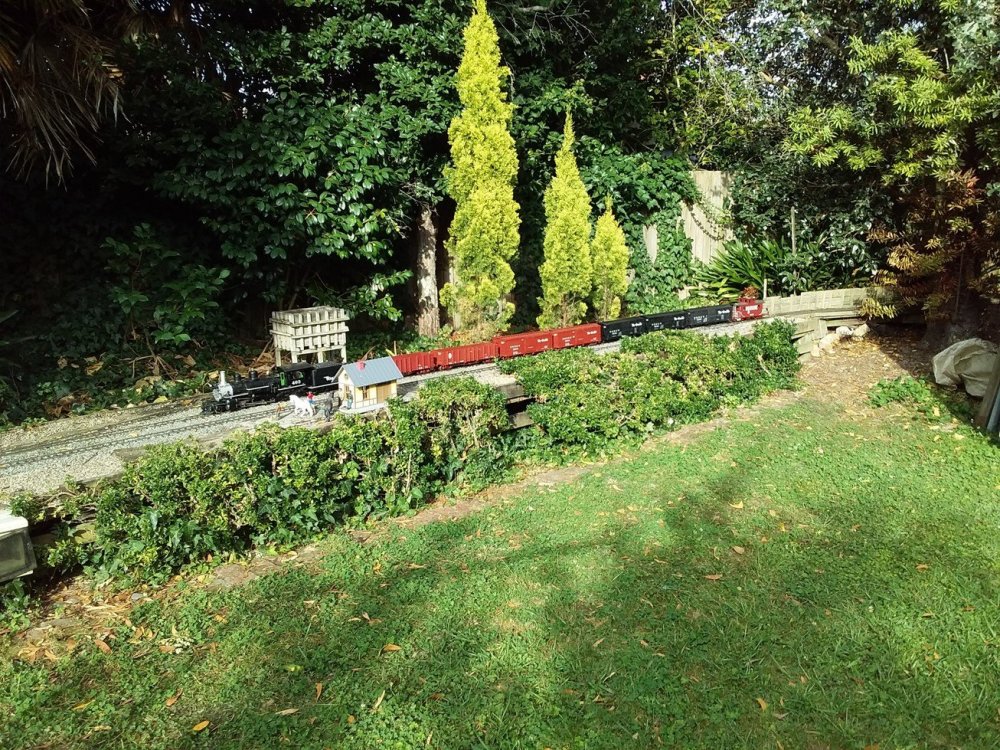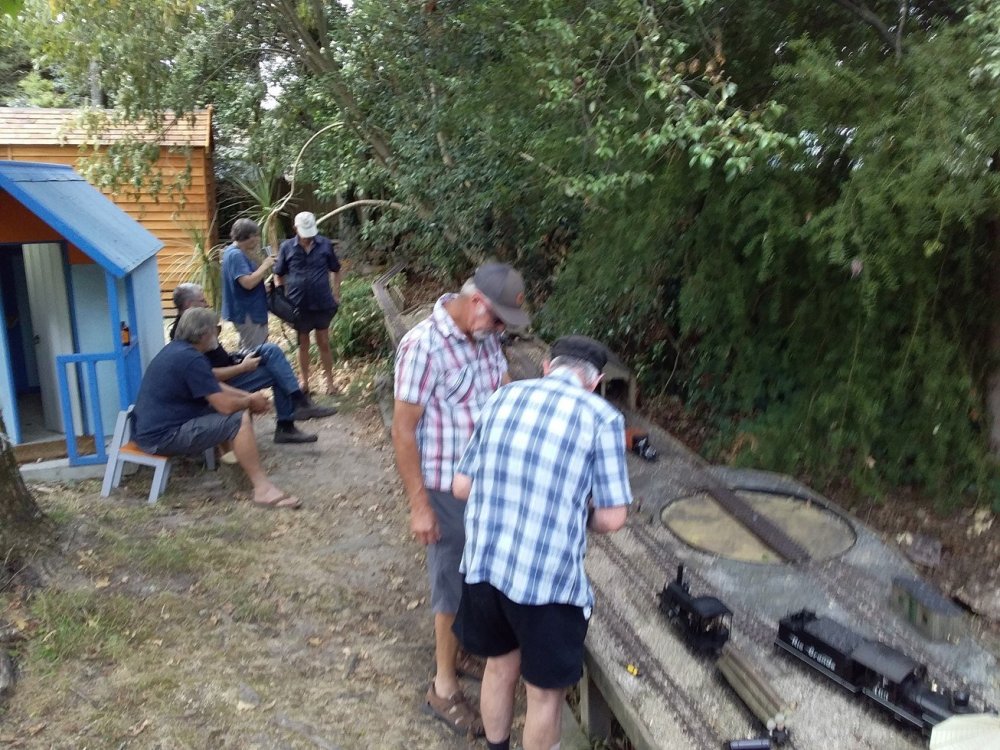-
Posts
4,858 -
Joined
-
Last visited
-
Days Won
119
Content Type
Profiles
Forums
Events
Gallery
Blogs
Store
Community Map
Everything posted by Mayner
-
The blocks behind the front buffers seems to have been a standard feature on standard GSWR passenger tank and tender locos including 0-4-4BT, Ivatt & Coey 2-4-2T & 4-4-2T, D14,17 & 19 4-4-0 and some of the larger Coey 4-4-0 classes. The designed the brake gear for my D17 on similar principal to No 44 but is likely to be a lot more fiddly to assemble in 4mm scale. The loco number brings back a vague memory of an engine-man's song. "The Gallant 44 her buffers were never wore.........."
- 24 replies
-
- 1
-

-
Seems to have been Light Ale a popular summer drink in Great Britain, the Isle of Man and Australasia. Both Ivo Peters and Norman Lockhart (the other photographer) were English and had decided to drown their sorrows following the general managers refusal. Having many English and Welsh friends (drinking buddies) I know from experience that they are as serious about their ales and bitter as the Irish are about Guinnes, Murphy's or Beamish. I once spent a very enjoyable fortnight in California with a group of British enthusiasts watching trains and taking photographs the only downside was that the popular American beer brands played havoc with our digestion until we found craft beer in an Italian restaurant with an Irish name in a sawmill town called Quincy. Only problem was that we cleared their stock of decent beer in one evening.
-
Ivo Peters an English Railway photographer (of Somerset & Dorset and Bentley fame) called into Skibbereen station in the Summer of 1950 having heard a rumour that an Ivatt 2-4-2T was working the Baltimore Branch train and was surprised to see one of the narrow gauge engines (6S) in steam pulling out the other two. Peters published photographs of the Schull & Skibbereen locos and mentions Fry in his books "Narrow Gauge Charm of Yesterday" & "Somewhere Along the Line". Ivo Peters spent a number of holidays in the South West and recorded steam working on the Kenmare Branch & Tralee and Dingle during the early 1950s. In Somewhere Along the Line Peters simply notes that Cyril Fry had arranged for the locos to be pulled out to be measured for modelling purpose. Photographers of Ivo Peters generation tended to work by the book and obtain permission to take photographs on the railway rather than just turning up or trespassing. In Somewhere Along the Line" Peters recounts an "interesting" 1961 meeting with Mr Sheard the General Manager of the Isle of Man Railway to request permission to take photographs of the railway. At the time the Company did not allow photography on railway property and refused to issue photographic permits to visiting enthusiasts. The meeting appears to have been reasonably civil until a rep. from the Tourist Board told Mr Sheared that Ivo Peters and a friend were recommended by British Railways, the General Manager nearly exploded banged his fist on the table twice and said "Permission Refused". The General Managers assistant and the man from the Tourist Board left leaving Mr Sheared seated with the two very disappointed enthusiasts, Peters asked the General Manager if he would like to join them for a beer and warmed to them after the second round and literally ended up giving them the red carpet treatment.
-
There is at least one influential modeler who models the Irish Broad gauge on EM gauge track. Using EM (18.2mm gauge) eliminates the narrow gauge head on appearance of a British or Irish OO gauge model and the conversion process is much more simpler than 21 mm gauge with drop in wheel sets and conversion sets suitable for the majority of rtr models, which largely eliminates the need to widen or replace coach bogies and wagon underframes. There is the added bonus of being able to run Irish and British outline stock on the one layout if you feel so inclined.
-
I think the most exceptional thing about the original Fry models is the sheer size and broad scope of the model collection rather than the actual standard of modelling which was pretty typical of the era Modeling complete trains in Irish Broad and Narrow Gauge, British and Continental including pre-Grouping/pre-Amalgamation to 1950s & 60s modern image. At the time scratchbuilding using hand tools was the normal practice for modellers that wanted anything different to a very limited range of expensive rtr in all the major modelling scales. Fry's original Irish International Railway and Tramway system appears to be a typical System model railway of the 1930s and 40s similar to Drew Donaldson's & Sam Carse's Irish layouts and the Rev Beales West Midland Railway. At the time it was not uncommon for modellers even in OOO (N) gauge to cast their own wheels and build their own motors and electrical control systems, some modellers in the larger scales O gauge upwards still cast or fabricate their own wheels. Fry had the advantage of being an insider with access to drawings and information on the prototype, there is a story of Cyril Fry arranging for the Schull and Skibbereen locos and stock to be pulled out of the shed at Skibbereen to be measured and photographed. He may have knowledge of production techniques and access to machine tools and skilled labour at Inchacore to assist with his modelling, there was an old joke that the Model Railway Society of Ireland was really the Aer Lingus Model Railway Society as some of the founding members had similar levels of access and assistance to the airlines metal working shops. Modellers have applied production techniques such as the use of profile cutting, jigs and fixtures to speed up or simplify the repetitive aspects of scratchbuilding from the early days of the hobby. 3D printing, laser cutting and etching are modern examples of these techniques. The quality of the finished model is as dependent on the knowledge and experience of the modeller in preparing working drawings and understanding the characteristics of the materials used regardless of whether the model is produced by hand using traditional scratchbuilding, by profile cutting, engraving or additive technology. The necessary knowledge and experience can only be gained by practice-practice and even more practice. Personally the main advantage of 3D printing and photo cutting over traditional scratchbuilding techniques is that it eliminates the risk of error in transferring a design from a drawing to the raw material and in machining or cutting out parts as aging effects my eyesight and ability to cut to a line or read a dial on a machine or gauge.
-
I think that many enthusiasts fail to appreciate that CIE and GSR (post 1933) were transport as opposed to railway companies with a policy of replacing loss making rail with road services once it was practicable. The West Cork and the majority of GSR/CIE branch and secondary lines were living on "borrowed time" once the GSR secured near monopoly powers over road transport services within the Free State from 1933 onwards. In 1938 the GSR submitted a proposal to close 861 miles of uneconomic railway lines, including the entire West Cork system to a Government tribunal on the future of the railways in the Free State. The Kinsale Branch closed completely in 1931 and the GSR proposed closing the Baltimore and Clonakilty lines in 1934 and had considered closing the Timoleague & Courtmacsharry as early as 1925. West Cork operation. 1. Courtmacsharry. The goods appears to have operated as required after passenger services closed with the Clonakilty Branch C Class operating the branch following dieselisation when the morning Clonakilty Junction-Clonakilty Mixed became a Mail Goods which worked the Courtmacsharry branch as required. Integrating the operation of the T&C and Clonakilty Branches in steam days would have been difficult due to the light axle loads and sharp curves on the branch. T&C branch locos were basically restricted to small contractors locos and ex-GSWR J30 0-6-0T until the Mid 1950s when MGWR J26 O-6-0T and later C Class diesels worked the branch. The Clonakilty line appears to have been mainly worked by ex-GSWR & DSER 2-4-2T in CIE days. The Weekly Circulars for cattle fairs and the Beet Season would have been interesting, did the "Bandon Tanks" work passenger, beet and cattle specials through from the Main Line to Ballinascarthy Junction, or did the Clonakilty or Courtmacsharry branch engine work trains from the T&C to Clonakilty Junction or even Albert Quay. Its believed that the J30 0-6-0s could only run light between Albert Quay and Ballinascarthy due to their small water tank capacity. 2. Baltimore Skibbereen appears to have been considered to be the terminus of the main line until main line passenger services were diverted to Bantry following the introduction of the AEC railcars in the early 50s. 6 couple locos were also barred from operating on the Baltimore extension which would have prevented through running of Bandon Tanks between Albert Quay and Baltimore. Its possible that the "Diesel Timetable" with the line apparently operated as two separate sub-branch lines may be a hangover from existing steam era working arrangements or shift patterns and would have helped to support the case that the West Cork lines were un-economic because of high operating costs. The most striking feature about the Baltimore diesel timetable is the absence of a morning service on the Extension apart from Saturdays 3. C Class Loco diagrams: 1960s WTT includes detail of Light Engine workings which helps to flesh out West Cork scheduled loco workings in its final years. A total of 4 C Class appear to have been allocated to scheduled goods, mixed train and passenger workings on the West Cork, Motive Power Control had developed a practice of swapping locos between branch and main line duties most likely to minimise the risk of failures and breakdowns. 1. The loco of the 3:45 Cork-Bantry Goods returned light to Drimoleague at 8:45 to work the 9:40 Drimoleague-Cork Goods. 2. The loco of the 7:00 Cork-Drimoleague Goods ran light to Bantry at 12:00 to work the 12:45 Bantry-Cork Goods The loco of the 12:45 Bantry-Cork Goods works a Drimoleague-Skibbereen-Drimoleague Mixed before departing for Cork at 4:40. 3. Drimoleague-Baltimore appears to have been worked by a single C Class based at Skibbereen. 4. Clonakilty Junction-Clonakilty working the T&C as required worked by a single C Class based at Clonakilty. Irish Railfans News stated that the locos of the Up goods trains appear to have swapped power with the engine of the Clonakilty Branch train on a weekly basis in order to return the loco to Cork for for maintenance purposes, its likely that similar power swaps also took place at Drimoleague avoiding significant light engine milage.
-
Apparently a number of LNWR signals in the North Wall Holyhead Yard survived the closure of the LNWR North Wall station in the 1920s and were in use at least until the re-modelling of the yard as a container terminal in the 1970s. The risk of a lower quadrant signal failing to return to danger if a signal wire breaks or because of snow or ice is a myth otherwise the Railway Inspectorates would have had to force the railways to phase out lower quadrant signals within a specific time frame rather than the UK Railway Inspectorate advising the railways to phase out lower quadrant signals as part of their signal renewal programme. The myth probably originated with the Abbots Ripton disaster in the 1870s when the arm of a slotted signal froze within the signal post and and failed to return to danger despite the signal mans best efforts. Originally slotted signals may have operated in a similar manner to American 3 position semaphore signals, with horizontal danger or Stop, 45° as Caution or Approach and vertical as Clear. The signal at Abbotts Ripton was set at clear with the arm vertical within the post and not visible to the driver of an approaching train. Early semaphore do not appear to have been "fail to safe" in that Clear may have been the normal position and the signal wire had to be pulled rather than released return the arm to the Danger position as the signal arm may not have been balanced by a heavy weight. In current British and Irish practice both lower and upper quadrant semaphore signals return to danger by gravity by a balance weight as a fail safe when the signaller returns the signal lever to it normal position in the frame or in the event of a signal wire breaking. The actual metal signal arms used by Irish Rail are extremely light in comparison with the weight of the spectacle plate and balance weight and sometimes a lower quadrant arm will bounce against the stop when a signaler returns a signal to danger. The main advantage of the semaphore is probably less effort for a signaller in "pulling" an upper quadrant arm into the off position and less wear and tear on the signalling system because of the lighter balance weight compared with a lower quadrant signal.
-
A high standard of detail and durability are the main advantages of using sheet metal construction. A well designed kit should be straightforward to assemble with minimum modification to allow components to fit together. I have to modify the pattern for the spring J hanger castings on these wagons as I am not happy with the castings & find the pattern I made for the container cuplocks that were later fitted to these wagons. The wagon in the photo is basically an EP to check fit and appearance, I have revised the design of the buffer beam and beefed up the fold down stanchions that were originally fitted to these wagons.
-
At least one rake of fertiliser wagons were converted to container wagons as fertiliser traffic tailed off during the mid-1990s. I remember seeing some converted wagons during a visit to Inchacore Works, but don't remember whether they kept their floors.
-
I don't appear to have posted photos of the assembled & painted MGWR vans. Still have not gotten round to lettering or fitting couplers over 6 years later. Train of fish vans. The original prototype Fish/Meat Van Dogbox end of MGWR Horse Box Grooms compartment end. Underframe showing brake pull rods. The vans live in a display cabinet but have got quite dusty.
- 21 replies
-
- 10
-

-

-
There is an excellent article with colour photos of the Killybegs layout in the November 2016 edition of New Irish Lines and the layout also appeared on the cover of the November 2017 edition. Both editions are accessible in the IRM archive https://www.dropbox.com/s/fppdhvdav7vjvos/New Irish Lines Vol. 7 No. 6 - 2016 November.pdf?dl=0 https://www.dropbox.com/s/xrgk5h1z95zw5go/New Irish Lines Vol. 8 No. 2 - 2017 November.pdf?dl=0
-
Classical spread panic and Black Market economy, my Galaxy phone has been swamped with adds for masks for the past month or so. We had panic buying on the weekend with supermarkets in Auckland sold out of baked canned food and toilet paper. Some of the buyers are believed to be stockpiling to sell on the blackmarket if there is a serious outbreak.
-
Cattle were often driven down the North Circular Road from the Cattle Market at least into the late 60s, I once saw a herd of cattle being driven (or stampeeding) across Summerhill Parade at speed, very little traffic on the roads in those days! I had a Grand Aunt that lived in a house on North Richmond Street her landlady's husband "Christy" was a cattle drover that worked between the Cattle Market and the Docks. My father had a story of a bull breaking loose on the North Circular Road early one morning on his way to work, being from a farming background he felt sorry for the bull who may have been put down.
-
There is the old saying that a horse will always find its way home to the stable or barn. That takes me back! Horse drawn vehicles were fairly common in Dublin up to the mid 1960s besides CIE, some of the coal distributors and scrap merchants used horse drawn vehicles, although milk and bread was delivered by small battery electric trucks. In the days before the large supermarket and relatively few people had cars, most of life's essentials were or could be delivered to your door by horse drawn or battery powered vehicle or messenger boys bike. Most grocers employed a "messenger boy" for bicycle deliveries- ending up on a "messenger boys bike" was the ultimate parents threat of a dead end job for kids that did not do well or apply themselves at school. Horse's had to be treated with care, otherwise the owner or driver could get in serious trouble with the animal welfare people. Some streets in Dublin particularly around Christchurch Cathedral were paved with cobble stones into the late 60s apparently to provide a better grip for horses shoes, but became dangerously slippy for horses after heavy motor vehicle use.
-

Narrow Gauge in the Rockies not quite
Mayner replied to Mayner's topic in US / Canadian Railway Modelling
We had our first garden railway group running day in a long time on Sunday, combination of people getting older, moving out of the region, finding the time or the motivation to play trains! While several of us wanted to run live steam a visiting battery powered LGB loco turned out to be the most reliable on what turned out to be a hot sunny afternoon. Visiting LGB Mogul on short freight Running trains/ taking it easy on a "Sunny Afternoon" Scratch built single cylinder oscillating tram loco chugs along. Line up of railtrucks at the loco depot. I moved the shed back from its usual position for the line up but will probably leave the shed in this position as it works well both visually and operationally, though I will need to extend the supporting framework. The K27 just about fits on the turntable which really works. My largest locos was a 2-8-0 when I installed the turntable. The train is on one of the 1st sections of track installed in 2007, although I had to replace the sleepers or ties in this area the treated timber framing has stood up well to the weather and will probably last another 12-3 years. -
There is some interesting background on the Cork & Youghal Railway on https://spellerweb.net/rhindex/Ireland/GreatSouthern/Youghal.html. The Cork and Waterford appears to have been promoted in connection with a Great Western Railway steam ship service from South Wales to Waterford, the cost of building and operating a line across the hilly country between Waterford and Youghal may have been a factor in the scheme being cut back to a Cork-Youghal Line. The GSWR planned Cork-Fermoy line via Waterglass Hill in the early 1900s to provide a more direct route than via Mallow for the Rosslare Express. Interestingly at one stage it was planned to transport dolomite limestone from deposits near Lombardstown on the Kerry Road to Ballinacourthy during the planning stages of the Quigley Magnesite operation which would have kept the western end of the Waterford-Mallow line in operation.
-
OO 1:76 basically evolved as a necessary compromise to allow mass produced models of British locos and stock to run on OO gauge track. Apart from the problems with the large motors of the 1920s & 30s into a HO body shell alluded to by the Minister, the larger scale was necessary to provide sufficient running clearance to allow models of British and Irish locos and stock run on small radius curves (less than 3') necessary for train set use and the majority of continuous run layouts in Ireland and the UK. While its feasible to build a reasonably large OO gauge layout in a relatively compact space with minimum 2' radius curves, you would need to increase the minimum radius to 3' for a 21mm gauge layout using OO/HO gauge track & wheel standards or a min radius of 4' for a modeller working to finer P4 or S4 wheel and track standards. While there is a certain attraction in tailoring the scale to suit an established track gauge particularly for narrow gauge models, it creates the additional problem of a model railway where the track is a different scale to the locos, stock, buildings, structures and vehicles. While 3mm scale appears to be a reasonable compromise for Irish broad and narrow gauge models, it aggravates the problems experienced by British modelers and manufacturers when they attempted to build HO scale British outline models in the 1920s.
-

CIE-built 1950s Wooden Coaching Stock (Pre - Laminate Stock)
Mayner replied to DiveController's topic in Irish Models
I always wondered if CIE managed to source a new supply of laminate panels for re-building the Laminate carriages in the late 70s-80s. I remember reading somewhere many years ago that the laminate panels were made up of an aluminium outer skin and insulated core and a plywood inner skin and thought asbestos insulation board (AIB) was a logical material for the insulated core. AIB contains brown asbestos which was not considered to be as hazardous as blue asbestos and its use was gradually phased from the late 80s. Laminate panel construction was a fairly novel way of speeding up carriage construction and it allowed CIE to introduce a large fleet of modern coaches within a 2-3 year timeframe. Its possible the 1964 carriages had timber frame construction as they had a similar upright end profile and panel cover slip detail to the 1953 coaches and 59 vans. The timber framing would have formed a nice cavity for sprayed blue asbestos insulation before fitting the interior veneer in what were intended to be state of the art coaches. I did not realise that CIE re-skinned the Park Royal coaches during the early 1980s, the carriage builders got very good a re-building coaches during those cash strapped days between the completion of the assembly of the MK2D Supertrain coaches and the beginning of the MK3 building programme.- 17 replies
-
- 1
-

-
- cie
- wooden coach
- (and 6 more)
-
Its believed that replacing the MK3 fleet with IRCs was more economical, in terms of operating and maintenance costs than a Mid-life refit of the MK3 Fleet. The big advantage from a customer service and operating perspective is that with a uniform carriage fleet IE has eliminated that "frayed edge of quality" problem which plagued BR & CIE with widely different types and standards of Intercity passenger stock. CIE originally planned to build at least some of the MK2D Supertrain, MK3 stock and the "International Train" as push-pull sets, particularly for use on Heuston-Waterford and Heuston-Limerick services. A MK2D driving cab mock up was assembled at Inchacore, the additional funding to assemble the coaches as push-pull stock does not appear to be available. A similar issue arose when the Government rejected IEs proposals to build railcars to replace Park Royal stock on commuter services arose in the late 80s. Approval was given to build 5 Push-Pull driving trailers convertible to railcars, the order for Intercity Coaches was reduced to 100, the remaining 24 coaches were built as Push-Pull trailers. In the big picture of things rail makes up a pretty insignificant proportion of Ireland passenger journeys (<5%) (OECD Performance Review 2000) it could be argued that the Irish rail users, IE and its workers are very lucky to have a railway, as the Irish Government would get a better economic and environmental return by abolishing CIE and de-regulating the bus and coaching industry.
-
Final assembly of the Ks/650 Class 2-4-0s In a way I prefer the GSR grey to the satin black of the MGWR version. The GSR Y boiler version appears to has a much more massive almost overstuffed appearance compared to the round topped boiler versions although the boilers were similar dimensions and pitched at the same height above rail level.
- 392 replies
-
- 13
-

-

-
I think the C Class in the double headed goods, may have been worked to Dungarvan in order to shunt the yard and return with a goods train to Waterford rather than as a result of a failure. Goods traffic was heaviest between Waterford and Dungarvan with an afternoon Waterford-Dungarvan-Waterford goods in addition to the daily Waterford-Mallow goods trains. The train may have been double headed with a driver in each loco or been hauled dead in the train, the Sulzers & C Class could not operate in multiple. The train 32 wagons including vans appears heavy for a single C Class on a steeply graded road and is substantially longer than other goods trains in the video and photos of goods trains. Its possible that the C Class is being worked to Dungarvan on a Waterford-Mallow goods rather than by working a separate Waterford-Dungarvan goods either as a result of a delay to the through goods or it was possible to work the Dungarvan traffic on the earlier train. The luggage van is likely to be carrying parcel traffic marshaled beside the guards van for convenience in dropping off and picking up traffic and minimise damage during shunting The 1960 working timetable had a daily 07:00 Mallow-Waterford goods with a corresponding 09:40 Waterford-Mallow goods both trains were scheduled to cross at Cappaquin with 8-9 hr running time over the 76 miles of the line. 12:10 Waterford-Dungarvan Goods with 3 hr running time and 5:00 pm Dungarvan-Waterford with 2:25 scheduled running time. 12:10 The Waterford-Dungarvan had a scheduled 57 minute stop at Kilmacthomas to shunt the yard and cross the Mallow-Waterford Goods. Goods traffic appears to have been very light between Dungarvan & Fermoy with short goods trains in photos and videos of the line in its final years.
-
I have always been fascinated by the Waterford-Mallow line since I first saw the section of line along the coast near Ballyvoyle and the causeway level crossing in Dungarvan in 1965-66 during a family road trip from Dublin to Cork via Waterford. I didn't see any trains on the Dungarvan line, but had the bonus of seeing (to me) a long goods train heading north along Wexford quay and staying in a guest house on Glanmire Road across from the City Railway. The passenger service was typically sparse with a single scheduled return passenger working between Cork & Waterford apparently worked by a Waterford based crew and single train set. The Rosslare Express operated 3 days weekly T,Th,S with a morning departure from Rosslare and an evening departure from Cork. Goods services were a little more intensive with one goods train in each direction daily between Mallow & Waterford scheduled to cross at Cappoquin and a daily return goods train between Waterford & Dungarvan. Goods traffic was sparse on the central section of the line between Dungarvan and Fermoy and heaviest between over the difficult heavily graded section between Dungarvan & Waterford. The Waterford-Mallow line closed to passenger and good services on 27th March 1967, so unlikely to be running in connection with the 4th June match between Cork & Waterford, its possible that the passenger train at 2:30 may be the Rosslare Express carrying peak summer holiday traffic or strengthened for another purpose. The Rosslare Express was mainly worked by Woolwich Moguls with the small wheeled Coey D4 on the Waterford passenger train and J15 on the goods. The B111 class took over passenger and goods working following dieselisation up to the arrival of the B121 Class. The Sulzers were well thought of because of the power, reliability and good traction and braking with their A1A A1A wheel arrangement over a challening route. The C Class on the double headed goods may have been for shunting at Dungarvan before a Dungarvan-Waterford goods with the B111 continuing on the Mallow.
-
The new timetable was adversely affected as a result of a work to rule at Inchacore Works which reduced locomotive availability and the 1st Oil Crisis. The timetable appears to have been based on single 1325 Hp 001 Class hauling the majority of Intercity trains with the 1650hp uprated locos working the Dublin-Tralee trains. The majority of additional services were cancelled, trains decelerated in the following timetable, with most of the radial routes loosing one return working daily, many of the additional services were not reinstated until the late 1990s. One effect of the cutbacks was longer heavier trains on the main routes, CIE introduced double heading with pairs of small Bo-Bos to speed up running from 75/76 on-wards before the introduction of the 071 Class. CIE shifted to Soviet diesel imported by Tedcastles in the mid 70s, possibly an attempt to secure supply and price. This followed Ireland opening diplomatic relations with the Soviet Union in 1973, not sure if the Soviets received payment in kind with Irish meat and dairy products, like Eammon Kellys story of the EEC selling the "Butter Mountain" to the Russians "to oil the axles of their carts" The Midland Railway in the UK operated on the light frequent high standard of comfort model up to its amalgamation into the LMS, the Midland was one of the first British railways to implement a centralised traffic train control system and was surrounded by competitors so it had to provide a superior service to stay in business, the NCC seems to have operated on a similar principal with a service of fast comfortable trains it lost money but the LMS had deep pockets to support its Irish subsidary.
-
Its possible that the Papal Legates train was double headed to put on a show of high speed non-stop running, rather than as break down insurance. If the lead loco failed, the train would most likely had to run at reduced speed until the dead loco was removed. A single A Class had a lower power output than a single 800 Class which usually hauled visiting Churchmen there is a photo of a line up of all 3 800 Class specially prepared to haul the Archbishop of Bostons train(s?) at Cork in 1949. 800 & 801 are all decked out in flags and insignia with the cleaners putting the final touches to 802 It looks suspiciously that the two A Class were recently overhauled and specially selected for an important run, rather than th3e best available locos in the running shed. Dan Renehan had a good account of Crossley operation in one of his IRRS papers. CIE allocated recently overhauled/repaired locos to main line passenger duties, re allocating locos onto less demanding passenger and freight duties by monitoring engine oil condition for signs of contamination arising from fuel contamination or water leakage as faults developed.
.png.c363cdf5c3fb7955cd92a55eb6dbbae0.png)



